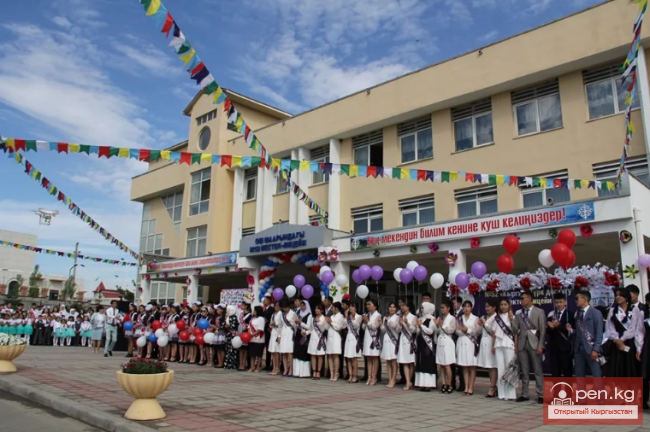Primary Education in the City of Osh
The city of Osh is not only a hub of industry but also a center of science, culture, and enlightenment. In the old days, there was only one Russian school in the city, where 2 teachers taught 65 students. In the lower city, there was a Russian-native school that only local bai and officials' children attended. During the Soviet era, the situation with public education changed dramatically. On May 20, 1918, a department of public education was established in the city. The first four Soviet schools were opened immediately: one upper primary school, which was later transformed into a secondary school, and three lower primary schools. The total number of students was 345.
The first Soviet teachers included Fasyilbek Kasymkanov, Mukhamed Aminov, Sadyvakas Khusainov, and others.
In the 1996-1997 academic year, there were already 50 general education schools in the city, including 16 Kyrgyz, 3 Russian, 18 Uzbek, 9 mixed schools, 7 kindergartens, 4 higher education institutions, 7 secondary specialized schools, and 4 vocational-technical schools. More than a thousand teachers worked in the schools. Among them was Khabira Khanum Izmailova, a distinguished teacher of the republic who raised several prominent leaders: Kamal Salahutdinov, a trade union activist; engineer Migaz Sagadieva; doctor Balbai Badalbaev; director of the Kashgar-Kishlak secondary school Abdullayev, and others.
Teacher Olilzhan Rakhmanov studied the activities of 38 graduates of the first Uzbek school named after Vata in Osh, organized back in 1925. Among them were: X. Abdullayev, a doctor of geological and mineralogical sciences, a laureate of the Lenin Prize, an honorary academician of 13 foreign academies, and former President of the Academy of Sciences of the Uzbek SSR; I. Sultanov, a doctor of philological sciences; M. R. Ismailin, a writer; N. Kamalov, a lecturer at Osh State University; I. Kadyrov, a doctor of pedagogical sciences, who later became the Minister of Public Education of the Uzbek SSR; Khaytakun Tashirov, a two-time Hero of Socialist Labor, chairman of a collective farm; M. Maksumov, a school director and head of the education department; Tadjikhan Khasanova, a People's Artist of the Kyrgyz SSR; Raziya Khan Mumunova, a People's Artist of Kyrgyzstan; L. Maidova, a People's Artist; G. Israilov, a theater director; and many others working in various sectors of the republic's economy.
One of the teachers in the city, Asan Rayimkulov, served as the director of the Tereshkova boarding school from 1969 to 1972, was the head of the Osh education department, and made a significant contribution to the development of public education. He admires the teaching staff of the school, with whom he worked for many years.
The director of Kyrgyz secondary school No. 17, K. Abdieva, recalls how the first Kyrgyz school was organized and its first directors, Sh. Nazaralova and S. Azhbekova. In 1997, there were 102 teachers at this school, and 8 teachers underwent training in the USA. The number of students was 1,700.
To retrain teachers, an improvement institute was established in Osh in 1962. The institute provides retraining and professional development for teachers and educational leaders in the region. It conducts pedagogical readings, scientific-practical conferences, and organizes various courses. The institute has 20 methodological rooms with a library of 3,500 copies. Over the years, more than 20,000 teachers and educational leaders have undergone retraining at the institute. There were 34 employees, including Aiperi Karibekova, head of the management staff room; Z. I. Fisenko, head of the Russian language room; and S. Azimkulova, head of the history and social studies room. The first director was O. Yuldashev, followed by A. Nuriyev and others.
Osh - 3000
